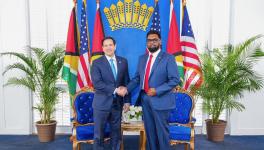US is in an Arms Race Against Itself

An unarmed Trident II D5 missile launches from the Ohio-class ballistic missile submarine USS Nebraska (SSBN-739). Photo: US Navy
On the anniversary of the bombings of Hiroshima and Nagasaki, we are once again compelled to reflect on the haunting specter of nuclear war. These attacks killed over 200,000 people instantly and left generations affected by radiation, trauma, and displacement. While some claim the bombs ensured peace, history tells a different story. Rather than closing a chapter of conflict, the atomic bombings coincided with the emergence of US hegemony – one that now appears to be slowly, painfully unraveling.
This aggressive military posture is not unprecedented – it mirrors other historical moments when waning empires responded to decline with violent overreach. Often, the most dangerous phase of a hegemon’s existence is not its rise but its fall. Since the proclamation of the Monroe Doctrine, US elites have viewed their destiny as one of global leadership – an assumption rooted in racialized and spiritual exceptionalism. Dislodging such beliefs will require far more than diplomatic charm. China’s diplomatic appeals to “win-win cooperation” may underestimate the depth of the US ideological and political commitment to supremacy.
In the face of emerging challenges to its global dominance, the United States has embarked on aggressive destabilization campaigns against its major perceived adversaries. Chief among them is China, which is on a clear path to surpass the US economically and has become a central engine of global growth and technological advancement. This trajectory not only implies future economic dominance but also hints at eventual military parity. Making matters more threatening from Washington’s perspective, China is actively constructing alternative networks of cooperation, building alliances meant to be resilient against imperialist intervention.
The Belt and Road Initiative, which includes over 150 countries; the Shanghai Cooperation Organization, currently involving eight member states and several observers; and ASEAN, arguably the most stable regional integration project in the Global South – all speak to China’s integration rather than isolation. Most alarming for the US, however, are China’s growing military exchanges and partnerships – ties that have not fractured even amid the war in Ukraine, despite US efforts to isolate Beijing.
In 2024 the Defense Intelligence Agency argued the US was entering a two-peer nuclear environment, citing the rapid modernization of China’s nuclear arsenal and its pursuit of a full triad. The report projects that China could possess approximately 1,500 nuclear warheads by 2035 – a number that would supposedly bring it to rough parity with the United States. To put this in context, during the Cold War, the US held as many as 31,000 warheads and currently maintains an estimated stockpile of around 3,700.
It’s worth noting that a key US ally, Israel, has long refused to acknowledge its own nuclear arsenal while simultaneously accusing Iran of nuclear ambitions, highlighting a striking hypocrisy. Today, only Russia, China, and the US possess Intercontinental Ballistic Missile (ICBM) capabilities – an essential marker of nuclear power. China’s development of fractional orbital bombardment systems, capable of evading radar and defense systems, are raised by the Pentagon as factors of concern. But rather than prompting measured diplomacy, this has been used as justification for intensified US rearmament.
The new US nuclear strategy: primacy
This perceived threat has been seized upon to advance a new US nuclear strategy. While the Cold War strategy of Mutually Assured Destruction (MAD) relied on deterrence through the threat of reciprocal annihilation, the post-Soviet era gave rise to a “counterforce” doctrine – one which involved building a robust arsenal capable of surviving a first strike and retaliating effectively. However, this approach has since evolved into an even more ambitious pursuit: nuclear primacy.
According to scholars Keir Lieber and Daryl Press, this shift began as early as 2006, long before China’s or Russia’s modernization efforts reached current levels. Rather than reacting to these developments, the US’s modernization reflects a decades-long ambition to dominate the nuclear arena – an ambition that has, arguably, spurred the very armament it now seeks to counter.
In its pursuit of nuclear primacy, the United States has committed to a sweeping modernization program projected to cost over USD 1.3 trillion. Key projects include the Sentinel ICBM (slated to replace the Minuteman III, in service since 1970), the B-21 Raider bomber, and Columbia-class nuclear submarines. These systems are designed for enhanced stealth, reliability, and ease of maintenance. The US also already possesses the B61-12, a nuclear bomb with adjustable yield and unprecedented accuracy, making it both a tactical and strategic weapon. When deployed underground, its destructive power is estimated to be equivalent to 83 Hiroshima bombs. The Department of Defense admits a major challenge to this rearmament: the erosion of its industrial capacity for fast, large-scale nuclear production.
Regardless of official rhetoric around deterrence and non-proliferation, the modernization drive makes one thing clear – the US is preparing for the possibility of fighting two nuclear peers simultaneously. This implicitly requires a first-strike capability, since any nuclear exchange would risk total civilizational collapse. Yet, in the calculus of US strategy, the pursuit of primacy appears to override such concerns.
Despite US media alarmism over peer capabilities – such as Russia’s hypersonic missile tests or joint military exercises with Iran and North Korea – US nuclear doctrine remains the most aggressive among the major powers. It upholds a first-strike policy and aims at nuclear primacy in the name of deterrence. Russia, by contrast, maintains a conditional first-strike posture, applicable only under existential threat – a shift driven by NATO’s post-Cold War expansion. China alone maintains an unambiguous no-first-use policy.
The Department of Defense claims that adversarial nuclear capabilities increase the risk of “opportunistic aggression” during broader conflicts – a term that implicitly accuses rivals of lacking restraint. But the reality remains that the US nuclear stance continues to rest on the unproven moral assumption that only it possesses the judgment to wield such devastating power. This is tacitly accepted by much of the West, despite the undeniable racialized logic at play and the chilling fact that the US remains the only nation in history to have used nuclear weapons.
The weapons industry
Another factor shaping US nuclear strategy is its powerful domestic arms industry. Weapons manufacturers maintain vast lobbying networks and have long exploited the country’s perpetual state of perceived insecurity. Successive administrations from both parties have used fear as a political tool to build consensus around unpopular, costly military projects. According to the Quincy Institute, the Nuclear Posture Review is largely dominated by the Pentagon, with little room for dissent from civilian agencies. The lack of campaign finance restrictions means weapons contractors can freely fund lawmakers, ensuring minimal resistance to the nuclear industrial complex’s expansion.
Despite these tensions, the US establishment remains unified in pushing for further rearmament, framing it as a defensive response to peer competition. Think tanks like the Atlantic Council advocate for NATO to enhance its nuclear capabilities, including sea-launched cruise missiles (SLCM-N) and exceeding current limits on warheads. At the same time, segments of the US intelligence community are pressing allies to shoulder more of the burden, portraying the US as unfairly tasked with defending the West from two simultaneous threats. This narrative conveniently omits the fact that, as recently as 2013, the Joint Chiefs of Staff determined that the US could safely reduce its arsenal by a third without compromising national security.
Treaties signed, treaties violated
The New START treaty, signed by the US and Russia in 2011 and extended in 2021, is due to expire on February 4, 2026. It limits each country to 1,550 deployed strategic warheads and restricts the number of launch platforms to 700 deployed and 800 in total.
However, the treaty was extended prior to the war in Ukraine and the resulting spike in US–Russia tensions. In 2023, Russia suspended its compliance with New START, citing US provocations such as the Nord Stream pipeline explosion and other aggressive actions – accusations which have not been adequately addressed in the Western media.
US deterrence goals face an inherent contradiction: Washington cannot reasonably expect Russia to limit its theater-range weapons without including British and French forces, as well as US missile defense systems, in a new agreement. Even though the US has no credible grounds to demand unilateral reductions from Russia, the media is poised to frame any Russian resistance to a new treaty as further evidence of its belligerence.
While the US continues to trumpet the language of great power competition, China articulates its geopolitical vision in terms of protecting its sovereign development path. But in the US worldview, Chinese sovereignty is redefined as aggression. This inversion makes clear that the US is not merely reacting to threats – it is actively constructing one of the most dangerous kind.
All nuclear strategies since Hiroshima and Nagasaki share one truth: massive civilian casualties are unavoidable. There is no such thing as a limited or controllable nuclear war. And yet, here we are – racing toward it, not away.
Stephanie Weatherbee Brito is the co-coordinator of the International Peoples Assembly (IPA).
Courtesy: Peoples Dispatch
Get the latest reports & analysis with people's perspective on Protests, movements & deep analytical videos, discussions of the current affairs in your Telegram app. Subscribe to NewsClick's Telegram channel & get Real-Time updates on stories, as they get published on our website.
























